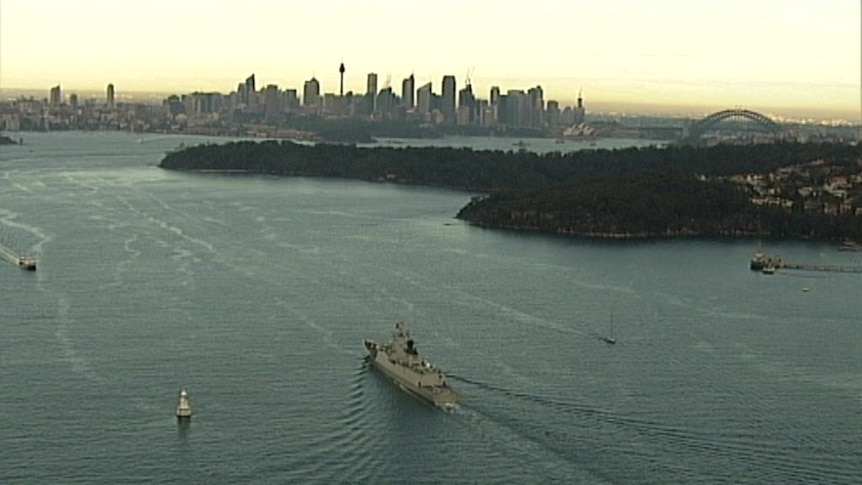Sydney Harbour Surveillance Intensifies Following Reports Of Chinese Ships

Table of Contents
Increased Patrols and Monitoring
The heightened concerns surrounding Chinese naval activity near Sydney Harbour have led to a noticeable intensification of patrols and monitoring efforts. Australian Defence Force (ADF) assets are significantly increasing their presence in and around the harbour, employing a multi-layered approach to maritime surveillance.
-
Increased air patrols by the Royal Australian Air Force (RAAF): RAAF aircraft, including P-8 Poseidon maritime patrol aircraft, are conducting more frequent surveillance flights over the harbour and surrounding waters. This allows for wide-area monitoring and early detection of any suspicious activity.
-
Deployment of additional naval vessels: The Royal Australian Navy (RAN) has deployed additional frigates and patrol boats to patrol Sydney Harbour and adjacent waters. These vessels provide a visible deterrent and offer a rapid response capability should any incident occur. This includes increased presence of smaller, agile vessels better suited for navigating the harbour's complex waterways.
-
Enhanced radar and sonar monitoring capabilities: Existing radar and sonar systems are being utilised at increased capacity, providing a comprehensive picture of shipping traffic in the area. This improved monitoring allows for the identification and tracking of all vessels operating in the vicinity of Sydney Harbour, enhancing situational awareness. Further investment in advanced sensor technology is also under consideration.
-
Collaboration between defence and civilian maritime agencies: Close collaboration between the ADF, Australian Border Force (ABF), and other civilian maritime agencies ensures a coordinated and comprehensive approach to maritime security. This collaborative effort leverages the expertise and resources of multiple agencies to enhance the effectiveness of surveillance operations. This includes sharing intelligence and coordinating responses. The use of satellite imagery and drone surveillance is also being explored for enhanced monitoring capabilities. The integration of various data streams into a centralized system allows for faster response times and improved decision-making.
Concerns Regarding Chinese Naval Activity
Reports of Chinese naval vessels operating near Sydney Harbour have raised serious concerns amongst Australian authorities and the public. The proximity of these ships to sensitive infrastructure, such as the Sydney Harbour Bridge and naval bases, adds to these concerns.
-
Types of Chinese vessels observed: Reports indicate the presence of various Chinese vessels, including intelligence-gathering ships and research vessels. The exact nature and purpose of these vessels remain a subject of ongoing investigation and analysis.
-
Locations of reported sightings: Sightings have been reported at various locations near Sydney Harbour, including the approaches to the harbour entrance and the waters off the coast of the city. The exact locations are often kept confidential for national security reasons.
-
Potential implications for national security: The presence of Chinese naval ships near Sydney Harbour raises concerns about potential espionage, data collection, and the potential for future disruptive actions. This underscores the importance of maintaining a strong maritime defence capability.
-
Official government statements: The Australian government has acknowledged the increased naval activity near Sydney Harbour, expressing its concerns while remaining cautious in its public statements to avoid escalating tensions. Statements often emphasize the right to monitor activity in accordance with international law.
The motivations behind the Chinese naval presence remain speculative. Potential reasons include intelligence gathering, mapping of critical infrastructure, and asserting a presence in the region as part of broader geopolitical strategy. Further investigation and analysis are needed to fully understand the purpose of these operations.
Public Reaction and Government Response
The increased Sydney Harbour surveillance and the reports of Chinese naval activity have generated a mixed public reaction. While some express concern about potential threats to national security, others question the extent of the government's response and its impact on civil liberties.
-
Public opinion: News articles and social media discussions reveal a range of opinions, from concerns about national security to criticism of potential overreach in surveillance activities. Public discourse emphasizes the need for balance between security concerns and individual freedoms.
-
Government's official response: The Australian government has publicly affirmed its commitment to maintaining maritime security and protecting national interests. Statements have emphasized its right to monitor activity in its territorial waters and beyond, in accordance with international law.
-
Changes to maritime security policies: While specifics remain confidential, there's evidence suggesting adjustments to maritime security policies and protocols to enhance detection and response capabilities. Increased information sharing between agencies is a key aspect of these changes.
-
Public statements from government officials: Government officials and defence personnel have regularly addressed the issue in public forums, emphasizing the need for vigilance and reassurance while remaining cautious in their messaging to avoid unnecessary escalation.
The government's transparency regarding the specifics of the increased surveillance has been a point of contention, with calls for greater clarity balancing the need for operational secrecy.
The Role of International Law and Diplomacy
The situation involving Sydney Harbour surveillance and Chinese naval activity is governed by international law, primarily the United Nations Convention on the Law of the Sea (UNCLOS).
-
UNCLOS and maritime surveillance: UNCLOS outlines the rights and responsibilities of nations concerning maritime surveillance within their territorial waters and in international waters. It allows for the monitoring of vessels to ensure compliance with international law and maritime safety regulations.
-
Rights and responsibilities: Nations have the right to monitor vessels within their Exclusive Economic Zones (EEZs) and territorial waters, but this right must be exercised in accordance with international law and without violating the sovereignty of other states.
-
Diplomatic implications: The situation carries significant diplomatic implications, demanding careful management of relations between Australia and China. Open communication and diplomatic channels are crucial for managing this complex situation.
Potential avenues for diplomatic engagement include bilateral discussions, participation in regional security forums, and adherence to established international protocols for managing maritime incidents. Open communication and de-escalation strategies are key components of a diplomatic approach.
Conclusion
The intensification of Sydney Harbour surveillance following reports of Chinese naval activity highlights the growing importance of maritime security in the Indo-Pacific region. The Australian government's response demonstrates a commitment to protecting Australia's national interests and ensuring the safety of its citizens. This situation underscores the complex geopolitical dynamics at play and the need for continued vigilance, employing appropriate resources, and maintaining open communication.
Call to Action: Stay informed about developments regarding Sydney Harbour surveillance and Chinese naval activity. Regularly check reputable news sources for updates and engage in informed discussion about Australia's national security. Understanding the complexities of Sydney Harbour surveillance is crucial for responsible citizenship. Learn more about Australia's maritime security strategy and the role of international law in governing naval operations.

Featured Posts
-
 Fortnite Item Shop Highly Requested Skins Return After 1000 Days
May 03, 2025
Fortnite Item Shop Highly Requested Skins Return After 1000 Days
May 03, 2025 -
 The Psychology Of Misinformation Cnns Perspective On Changing Minds
May 03, 2025
The Psychology Of Misinformation Cnns Perspective On Changing Minds
May 03, 2025 -
 Is The Buy Canadian Trend Fading Loblaws Ceo Weighs In
May 03, 2025
Is The Buy Canadian Trend Fading Loblaws Ceo Weighs In
May 03, 2025 -
 Fortnite Cowboy Bebop Bundle Price Get Faye Valentine And Spike Spiegel Skins
May 03, 2025
Fortnite Cowboy Bebop Bundle Price Get Faye Valentine And Spike Spiegel Skins
May 03, 2025 -
 David Tennant And The Max Harry Potter Series A Return Ruled Out
May 03, 2025
David Tennant And The Max Harry Potter Series A Return Ruled Out
May 03, 2025
